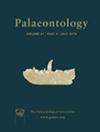一种保存完好的苏格兰志留纪无颌鱼
IF 2.3
2区 地球科学
Q1 PALEONTOLOGY
引用次数: 2
摘要
非生物矿化、软体类群的化石记录是脊椎动物早期历史的唯一直接证据。对这些类群亲缘关系的可靠重建对于解开脊椎动物起源和理解骨骼组织的进化至关重要,但这些类群总是具有不稳定和缺乏支持的系统发育位置。在矿化的骨脊椎动物和完全软体脊椎动物之间的尖端是神秘的Lasanius,据称是来自苏格兰志留纪的一种anaspus。对其亲和性和重要性的解释是相互矛盾的,主要是因为它的解剖结构由于词形扭曲和软组织的丢失而知之甚少。在这里,我们通过对229个完整和部分标本的全面研究,使用一系列现代技术来重新评估Lasanius的解剖结构。新的重建澄清了保存特征的身份和位置,包括成对的感觉器官,脊索和消化道,支持该属的脊椎动物亲缘关系。SEM - EDS微量元素图谱显示矿化部分有骨样成分,但没有发现矿化皮肤盔甲的证据。系统发育分析表明Lasanius是早期的干-齿环畸形,随后的分析支持了对其他位置(如干-齿环畸形)的否定。我们强调,虽然区分早期环口和颌口是有问题的,但增加对关键分类群(如Lasanius)的解剖信心,对于增加整个早期脊椎动物树的稳定性至关重要。本文章由计算机程序翻译,如有差异,请以英文原文为准。
Lasanius, an exceptionally preserved Silurian jawless fish from Scotland
The fossil record of non‐biomineralizing, soft‐bodied taxa is our only direct evidence of the early history of vertebrates. A robust reconstruction of the affinities of these taxa is critical to unlocking vertebrate origins and understanding the evolution of skeletal tissues, but these taxa invariably have unstable and poorly supported phylogenetic positions. At the cusp between mineralized bony vertebrates and entirely soft‐bodied vertebrates is the enigmatic Lasanius, a purported anaspid from the Silurian of Scotland. Interpretations of its affinity and significance are conflicted, principally because of its poorly understood anatomy due to taphonomic distortion and loss of soft‐tissues. Here we use an array of modern techniques to reassess the anatomy of Lasanius via a comprehensive study of 229 complete and partial specimens. A new reconstruction clarifies the identity and position of preserved features, including paired sensory organs, a notochord, and digestive tract, supporting the vertebrate affinities of this genus. SEM‐EDS trace element mapping suggests a bone‐like composition of mineralized parts, but finds no evidence for mineralized dermal armour. Phylogenetic analysis recovers Lasanius as an early stem‐cyclostome, and subsequent analysis supports the rejection of alternative placements (such as stem‐gnathostome). We highlight that while distinguishing between the early cyclostome and gnathostome condition is problematic, increasing confidence in the anatomy of key taxa, such as Lasanius, is vital for increased stability throughout the early vertebrate tree.
求助全文
通过发布文献求助,成功后即可免费获取论文全文。
去求助
来源期刊

Palaeontology
地学-古生物学
CiteScore
5.60
自引率
3.80%
发文量
43
审稿时长
6 months
期刊介绍:
Palaeontology publishes a wide variety of papers on palaeontological topics covering:
palaeozoology
palaeobotany
systematic studies
palaeoecology
micropalaeontology
palaeobiogeography
functional morphology
stratigraphy
taxonomy
taphonomy
palaeoenvironmental reconstruction
palaeoclimate analysis and biomineralization studies.
 求助内容:
求助内容: 应助结果提醒方式:
应助结果提醒方式:


